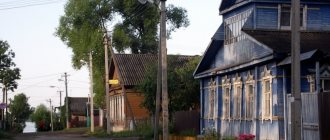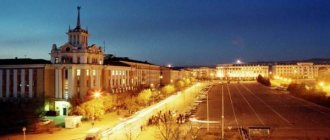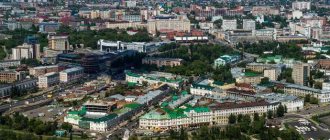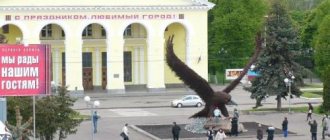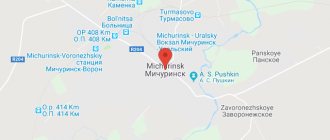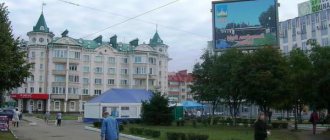The Bryansk region is located on the border with Ukraine and Belarus and is included in the Central Federal District. The total population for 2021 is 1 million 200 thousand. Density - 34 people per 1 m². As of 2021, the number of urban residents has reached 70%. There is no downward trend yet.
The list of the population by nationality is divided into:
• Russians - their dominant majority, according to the 2010 census - 96.7%; • Ukrainians - 1.1%; • Belarusians - 0.4%; • Armenians - 0.4%.
Representatives of all other nationalities are slightly more than 1%. No interethnic or interfaith conflicts were recorded. In terms of worldview, atheists, agnostics and Orthodox Christians dominate.
Bryansk is the largest regional city
The number of residents of Bryansk is, according to data for 2021, 405 thousand. It is one of the oldest settlements in the region, first mentioned in written sources back in 1146. The number of residents has decreased in recent years, although a positive trend is still observed periodically: in 2010 and 2017. there was an increase.
Bryansk attracts specialists in the field of industry, primarily in the field of metal processing. It is a large industrial city, thanks to which the economic situation here is favorable. This settlement is the most important railway junction in the economic direction. It is connected by routes to Moscow, Orel, Gomel, Vyazma, as well as other major locations. This is attractive to potential migrants, as it greatly facilitates the eventual relocation.
Bryansk region
Geographical position
The Bryansk region is located in the central part of the East European Plain. It borders with two states at once: in the south - with Ukraine, in the west and north-west - with Belarus, as well as with four constituent entities of the Russian Federation: in the north - with the Smolensk region, in the north-east - with the Kaluga region, in the east - with Oryol region, in the southeast - with Kursk region. The area of the region is 34.9 thousand square meters. km. The length from west to east is 270 km, from north to south – 190 km. In terms of territory, the Bryansk region is 13 times larger than states such as Belgium, the Netherlands and Luxembourg.
Municipal structure
The Bryansk region includes 289 municipalities, including 6 urban districts (Bryansk, Klintsy, Novozybkov, Seltso, Starodub, Fokino), 27 municipal districts, 30 urban settlements, 226 rural settlements (2018). The administrative center of the region is the city of Bryansk. Largest cities: Klintsy, Novozybkov, Dyatkovo.
Population
region as of January 1, 2021 amounted to 1,210,912 people, 0.89% of the population of the Russian Federation. Population density – 35.97 people/sq. km. Urban population – 69.33%.
Natural conditions and minerals
Located at the junction of three republics and two natural zones, the region has a rich and diverse nature. Here you can find all types of forests: coniferous, mixed, broad-leaved, as well as forest-steppe and cultivated steppe. More than 1.15 million hectares are occupied by forests. The most valuable forests are coniferous, which occupy 53% of forest areas. There are up to 80 species of trees and shrubs in the forests. Total timber reserves are about 138 million cubic meters.
The territory of the Bryansk region is covered with a fairly dense river network - there are more than 120 rivers with a total length of 9 thousand km. Almost all rivers belong to the basins of the Black and Caspian Seas. Almost all rivers in the region flow into the Dnieper and its tributaries. The main river of the region is the Desna.
The region has significant reserves of natural raw materials (cement raw materials, carbonate rocks, glass sands, clays, tripoli, chalk) for the building materials and glass industries, developed peat reserves, and phosphate-containing ores for the production of mineral fertilizers. In total, there are up to 80 deposits of various mineral raw materials in the region.
The main wealth of the Bryansk region is its peat reserves, which are 1.4 times greater than the reserves of the Oryol, Kaluga, Tula and Kursk regions combined. Peatlands spread over 82 thousand hectares, and taking into account forest peat deposits, their area reaches 125 thousand hectares. In total, there are over 630 peat deposits in the region, the largest: “Kozhanovskoye”, “Rekta” in the Klintsovsky district, “Chistoe”, “Teploye” - in Bryansk, “Vyazovskoye” - in Zhukovsky.
One of the most studied minerals in the region after peat is phosphorites. The Bryansk region is the birthplace of industrial mining and processing of phosphorites. Currently, only the Polpinskoye field, located on the northeastern outskirts of Bryansk, is used. Its reserves are estimated at 62 million tons.
Also in the region there are deposits of glauconite, sapropel, marl, etc.
Main socio-economic indicators
The leading types of economic activity are manufacturing; wholesale and retail trade; agriculture, hunting and forestry construction; transport and communications, which account for about 62% of GRP produced.
The industrial complex is represented by more than 300 large and medium-sized enterprises, and over 7 thousand small enterprises. Mechanical engineering and metalworking, production of building materials, and production of wood products are developed. More than 1.3 thousand enterprises and peasant (farm) farms are involved in the agro-industrial complex. Livestock farming, crop production and seed production are developed.
The processing and food industries form the basis of the region's food security. The state of the mineral resource base allows us to maintain the high industrial potential of the region’s construction industry and export cement raw materials to other regions of Russia.
Agriculture. The total area of agricultural land in the Bryansk region is 1.9 million hectares, of which 1.2 million hectares are arable land. Livestock farming is developed - dairy and meat cattle breeding and poultry farming. The main specialization of crop production is the cultivation of grain crops (rye, wheat), potatoes, flax, vegetables, sugar beets. In recent years, grain production in the region has been steadily growing, and sugar beet plantings are expanding.
Photo: Government of Bryansk region
Klintsy is the second largest city in terms of population
This city is the second most populous in the region. As of 2021, almost 63 thousand people lived in it; together with the suburbs, the total number reached 70 thousand. The largest factory in Russia for the production of truck cranes is located here. Other industrial areas are also well developed, so Klintsy shows a steady trend of development. Thanks to this, the population has also been constantly growing in recent years. By nationality, the majority of people here are Russians.
POPULATION page
Since ancient times, the Slavic tribes of the Vyatichi, Radimichi, and Northerners lived on the territory of the region. Traces of their settlements are found in a number of areas of our region. Place of the ancient Slavic settlement “Chashin Kurgan” (Bryansk)
The oldest cities are: Bryansk, Karachev, Mglin, Pogar, Sevsk, Starodub, Trubchevsk.
The average population density in the region is about 37 people per square kilometer. It is distributed unevenly: the Bryansk, Unecha, Dyatkovo and Pochepsky districts are the most densely populated; less so - Zhiryatinsky, Rognedinsky, Gordeevsky and Novozybkovsky districts.
Changes in the population of the Bryansk region (according to all-Union and all-Russian censuses)
| Year | 1959 | 1970 | 1979 | 1989 | 2002 | 2010 |
| total population, people | 1549945 | 1581950 | 1506850 | 1 474 785 | 1378941 | 1278087 |
| urban population, people | 539814 | 749849 | 888259 | 991863 | 943382 | 883326 |
| urban population, % | 24,8 | 47,4 | 58,9 | 67,3 | 68,4 | 69,1 |
There are 2,658 settlements in the region. Approximately 69% of the population lives in cities and towns, the rest in rural areas. There are 16 cities in the region (Bryansk, Klintsy, Novo-zybkov, Dyatkovo, Zhukovka, Pochep, Unecha, Sevsk, Trubchevsk, Zlynka, Mglin, Pogar, Starodub, Surazh, Seltso, Fokino). The largest city in terms of population is Bryansk - 415 thousand inhabitants. The remaining cities have significantly smaller populations.
Today in the Bryansk region there are 24 urban-type settlements: 11 of them are regional centers. The most populated urban settlement is Na-lya (14,361 inhabitants). Other largest urban settlements: Klimovo - 13,892 inhabitants, Kletnya - 13,312 inhabitants, Lokot (district center of the Brasovsky district) - 10,028 inhabitants, Pogar - 9,990 inhabitants. The smallest urban settlement in the Bryansk region is the town. Ramasukha Pochepsky district with 481 inhabitants.
The main population of the region is Russians (96.3%), Ukrainians (1.5%), Belarusians (0.6%), Armenians and Gypsies - 0.3% each. In general, more than 50 nationalities live in the region This is explained by the historical development of the territory and its border position.
The lives of many famous people of our Motherland are connected with the Bryansk region. This is the poet and playwright A.K. Tolstoy, poet F.I. Tyutchev, prose writers N.S. Leskov, N.M. Gribachev, E.G. Kazakevich, composer M.I. Blanter, artist Z.A. Mamontova, biologist M.N. Bazhenova, academician I.G. Petrovsky, historian, geographer E.F. Zyablovsky and others.
Novozybkov is large by local standards
Novozybkov ranks third in terms of population in the region. As of 2021, about 40 thousand people live here. This settlement is attractive for its unusual history. It was founded in 1701, mainly Old Believers were located here.
Gradually the city grew and acquired the status of a district town. The cultural context as a place of peculiar exiles and dissidents remained. In modern history, this is emphasized by the fact that the surrounding areas were exposed to radioactive contamination as a result of the accident at the Chernobyl nuclear power plant. The exclusion zone begins 1 km west of the city.
Urban settlements
- Navlya
Population 14,210 (2020).
- Klimovo
Population 12,743 (2020).
- Kletnya
Population 12,284 (2020).
- Elbow
Population 9,243 (2020).
- Suzemka
Population 8,554 (2020).
- White Shores
Population 8,450 (2020).
- Fire
Population 8,351 (2020).
- Komarichi
Population 7,714 (2020).
- Dubrovka
Population 7,046 people (2020).
- Red Mountain
Population 6,332 (2020).
- And so
Population 6,189 (2020).
- Lyubohna
Population 6,067 people (2020).
- Bolshoye Polpino
Population 5,985 (2020).
- White Birch
Population 5,555 (2020).
- Vygonichi
Population 5,006 people (2020).
- Bytosh
Population 4,379 (2020).
- Old
Population 4,323 (2020).
- Raditsa-Krylovka
Population 3,334 (2020).
- Rognedino
Population 2,856 (2020).
- Vyshkov
Population 2,673 (2020).
- Kokorevka
Population 1,694 (2020).
- Altuhovo
Population 1,608 people (2020).
- Ramasuha
Population 390 people (2020).
Dyatkovo is a village with city status
This village has been known since 1626. City status was received already in 1924. At the moment, the total number of residents is about 26.7 thousand. At the same time, the trend is negative, which is primarily due to the lack of places for employment and weak prospects. The majority of the population (98%) are Russians.
The main city-forming enterprise is the Dyatkovo Crystal Factory. Its products are widely known not only in Russia, but also abroad. Thanks to this plant, it was possible to erect a unique temple, the Burning Bush, where the only crystal iconostasis in the world was installed. The point is also widely known for its sources. In recent years, natural and architectural attractions have begun to be revived, and interest in the original crystal museum has increased. All this creates good potential for the development of the tourism industry.
Starodub - ancient and small in number
Today the number of people living in Starodub (as of 2018) is 18 thousand people. This is an ancient city, the exact date of its foundation is unknown. It has been established that in 1080 we were already talking about a fairly powerful settlement. In the past it was the center of the Seversk land. The property of this place is the layout that has been preserved since ancient times, which makes it easy to reconstruct ancient settlements.
The city-forming enterprises belong to the food industry. Starodubsky cheese and canned food are produced here. Previously, bread and local sausages were produced here. At the moment, both companies have gone bankrupt. The city's greatest potential is related to tourism, but for this it needs to be developed.
Small towns of less than 20 thousand people
Starodub
Population 18,156 people (2020).
Karachev
Population 17,169 (2020).
Zhukovka (Bryansk region)
There are other settlements and objects with the same name
Population 16,448 (2020).
Seltso (Bryansk region)
There are other settlements and objects with the same name
Population 16,368 (2020).
Pochep
Population 16,389 (2020).
Trubchevsk
Population 13,613 (2020).
Fokino (Bryansk region)
There are other settlements and objects with this name, see Fokino
Population 12,759 (2020).
Suraj
Population 10,728 (2020).
Mglin
Population 7,145 (2020).
Sevsk
Population 6,563 (2020).
Zlynka
Population 5,340 people (2020).
Karachev is an ancient city with a small population
Karachev is a point in the Bryansk region, in which, according to last year, 17.7 thousand people lived. It is one of the oldest in Russia. Surprisingly, in 1146 it already existed. At that time it was the center of the Karachev principality. Now Karachev is in outright decline. There are several factories operating in the village, including those producing electrical parts, but most are in a state of outright decline. Nothing concrete is known about the possibility of restoring the city through tourism.
Content
- 1 Large cities 250-500 thousand people 1.1 Bryansk
- 2.1 Klintsy
- 3.1 Starodub
